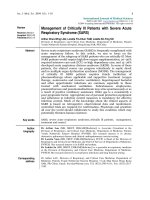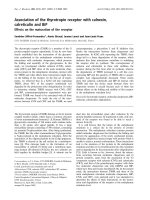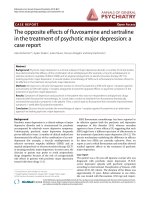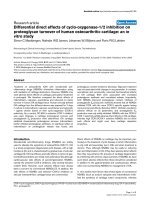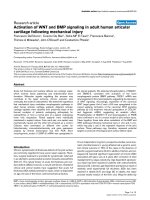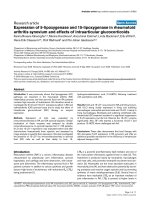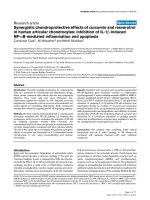Báo cáo y học: " Examination of effects of GSK3β phosphorylation, β-catenin phosphorylation, and β-catenin degradation on kinetics of Wnt signaling pathway using computational method" pdf
Bạn đang xem bản rút gọn của tài liệu. Xem và tải ngay bản đầy đủ của tài liệu tại đây (320.2 KB, 9 trang )
BioMed Central
Page 1 of 9
(page number not for citation purposes)
Theoretical Biology and Medical
Modelling
Open Access
Research
Examination of effects of GSK3β phosphorylation, β-catenin
phosphorylation, and β-catenin degradation on kinetics of Wnt
signaling pathway using computational method
Ying-Chieh Sun
Address: Department of Chemistry, National Taiwan Normal University, 88, TingChow Road Section 4, Taipei 116, Taiwan
Email: Ying-Chieh Sun -
Abstract
Background: Recent experiments have explored effects of activities of kinases other than the
well-studied GSK3β, in wnt pathway signaling, particularly at the level of β-catenin. It has also been
found that the kinase PKA attenuates β-catenin degradation. However, the effects of these kinases
on the level and degradation of β-catenin and the resulting downstream transcription activity
remain to be clarified. Furthermore, the effect of GSK3β phosphorylation on the β-catenin level
has not been examined computationally. In the present study, the effects of phosphorylation of
GSK3β and of phosphorylations and degradation of β-catenin on the kinetics of the wnt signaling
pathway were examined computationally.
Methods: The well-known computational Lee-Heinrich kinetic model of the wnt pathway was
modified to include these effects. The rate laws of reactions in the modified model were solved
numerically to examine these effects on β-catenin level.
Results: The computations showed that the β-catenin level is almost linearly proportional to the
phosphorylation activity of GSK3β. The dependence of β-catenin level on the phosphorylation and
degradation of free β-catenin and downstream TCF activity can be analyzed with an approximate,
simple function of kinetic parameters for added reaction steps associated with effects examined,
rationalizing the experimental results.
Conclusion: The phosphorylations of β-catenin by kinases other than GSK3β involve free
unphorphorylated β-catenin rather than GSK3β-phosphorylated β-catenin*. In order to account
for the observed enhancement of TCF activity, the β-catenin dephosphorylation step is essential,
and the kinetic parameters of β-catenin phosphorylation and degradation need to meet a condition
described in the main text. These findings should be useful for future experiments.
Background
The Wnt/β-catenin signaling pathway (named wnt path-
way hereafter for simplicity) plays a significant role in cell
proliferation, differentiation, and apoptosis. These have
implications for aspects of cell development, stem cells
and cancer [1]. Many characteristics of this pathway and
its role in cell signaling have been revealed in experimen-
tal studies (for review, see for example [1], and references
therein and the literature listed at n
ford.edu/~rnusse/wntwindow.html). Briefly, wnt signal-
ing enhances the level of the output signal protein,
unphosphorylated β-catenin, which then binds with TCF
Published: 22 July 2009
Theoretical Biology and Medical Modelling 2009, 6:13 doi:10.1186/1742-4682-6-13
Received: 22 April 2009
Accepted: 22 July 2009
This article is available from: />© 2009 Sun; licensee BioMed Central Ltd.
This is an Open Access article distributed under the terms of the Creative Commons Attribution License ( />),
which permits unrestricted use, distribution, and reproduction in any medium, provided the original work is properly cited.
Theoretical Biology and Medical Modelling 2009, 6:13 />Page 2 of 9
(page number not for citation purposes)
to induce associated gene expression in the nucleus. At
steady state (SS), the level of β-catenin is balanced by its
synthesis and degradation. The so-called destruction cycle
is a major mechanism of degradation, in which phospho-
rylation of β-catenin by GSK3b is a key step [2]. When the
wnt signal acts on cell, wnt recruits several proteins to
attenuate the reaction rate of this key step, slowing down
the degradation. Therefore, β-catenin accumulates,
enhancing the level of TCF/β-catenin complex and the
resulting associated gene expression.
Recent advances have further illustrate how phosphoryla-
tion and dephosphorylation of major components in the
wnt pathway affect the stability of β-catenin and its TCF
transcription activity [3-7]. It has been found that LRP6
phosphorylates GSK3β and regulates β-catenin independ-
ently of the axin pathway [3]. PKA phosphorylates GSK3β
and affects the β-catenin level in Saos-2 cells [4]. β-catenin
is also phosphorylated by AKT at Ser552, promoting TCF
activity [4]. Furthermore, PKA phosphorylates Ser552 and
Ser675 of β-catenin but this does not affect the β-catenin
level in COS7 cells [5]. Moreover, CK1 phosphorylates
not only axin and APC but also GSK3β and β-catenin [6].
A newly identified component, PP1, dephosphorylates
axin [6]. In addition, phosphorylation of β-catenin at
Ser675 by PKA attenuates β-catenin degradation, stabiliz-
ing β-catenin and enhancing TCF activity in the cells
investigated [7]. In aspects of pathology, β-catenin has a
role in carcinogenesis although the extent of its effect var-
ies among cancers [8]. For example, the effect on colorec-
tal cancer is more significant than on lung cancer. In a
recent study [9], a derivative of celecoxib, derivatives of
which have been extensively examined for anti-cancer
treatment, was found to have potential for treating lung
cancer. Proteomics examination showed that PKA activity
has a significant effect on the wnt signaling pathway and
in differentiating lung from normal cells.
In addition to experimental studies, computational stud-
ies have also aided understanding of the dynamical
behaviors of this pathway and how it interacts with other
pathways [2,10-13]. The wnt pathway is one of the com-
putationally best-studied signaling pathways [14-16]. The
kinetics of β-catenin, axin, and other proteins have been
examined in the well-established Lee-Heinrich model [2],
following the nomenclature in [12], which was built on
the basis of experiments with Xenopus. Briefly, the Lee-
Heinrich model contains a number of key protein compo-
nents in the wnt pathway shown in Figure 1[2]. (Note that
a kinase, casein kinase 1 (CK1), was recently implicated in
the activation of β-catenin phosphorylation by GSK3β [6],
and this was not included in the Lee-Heinrich model. This
kinase is not directly related to the three effects examined
in the present study. Therefore, it is not included here.)
Binding of proteins, catalytic activities, phosphorylation
reactions, etc. are described by their corresponding kinetic
rate laws with the associated parameters, which were
obtained from measurements or estimated [2]. Effects of
wnt signaling and changes of activity of some compo-
nents on the kinetics of the pathway can be investigated
by solving kinetic rate law equations [2]. A number of the
effects examined and the kinetics of components were in
excellent agreement with experimental results [2].
In addition to the Lee-Heinrich model of the wnt pathway
itself, this model has been used and extended to examine
the effect of Apc mutations on the wnt signaling pathway
[10], cross-talk with the ERK pathway [11], and the inter-
action of axin2 proteins with the wnt pathway [12]. While
many characteristics of this pathway have been elucidated
both experimentally and computationally, much of its
role in cell signaling and the means by which it interacts
with other pathways remain to be explored.
In the present study, in the light of the recent experimental
studies described above [3-7], I aimed to examine the
effects of GSK3β phosphorylation, β-catenin phosphor-
ylation by kinases other than GSK3β (referred to as β-cat-
enin non-GSK3β phosphorylation hereafter), and β-
catenin degradation on the kinetics of the wnt pathway
using a computational method based on the Lee-Heinrich
model. These effects were not included explicitly in the
Lee-Heinrich model, and to my knowledge, they have not
previously been examined computationally. The present
computational study should elucidate how these effects
affect the wnt pathway. The reaction steps of GSK3β phos-
phorylation, β-catenin non-GSK3β phosphorylation, and
β-catenin degradation were added to the Lee-Heinrich
model (see added reaction steps in blue in Figure 1). The
dependence of SS concentrations on the associated kinetic
parameters of interest in these reaction steps was exam-
ined. Control coefficients of selected parameters and time
courses of selected components with wnt signalling were
calculated and examined as well. The method is described
in Section II. Section III presents the results and discus-
sion. Conclusions are given in the final section.
Methods
The COPASI program [17] was used to solve kinetic rate
equations numerically in order to simulate the wnt path-
way. I first built the Lee-Heinrich model of the wnt path-
way and reproduced the SS concentrations and several
time course concentration curves, shown in Table 2 and
Figure 6 in Ref. [2], respectively. The reproduced results
are shown in Table 1 and the solid lines in Figure 3. The
newly-added and examined effects of GSK3β and β-cat-
enin non-GSK3β phosphorylations were assumed to
involve free GSK3β and β-catenin only. An experimental
study [7] showed that these two proteins are less likely to
be phosphorylated in the complexes than in the free
Theoretical Biology and Medical Modelling 2009, 6:13 />Page 3 of 9
(page number not for citation purposes)
forms. Additions of these two reaction steps along with
their dephophorylation steps, assigned as reaction steps
18 and 19, respectively, and degradation of β-catenin,
reaction 20, are shown in blue in Figure 1. The rate laws
for these reactions are the kinetic equations for standard
first order reversible (steps 18 and 19) and irreversible
(step 20) reactions. β-catenin non-GSK3β phosphoryla-
tion and degradation were assumed to take place inde-
pendently with un-phosphorylated β-catenin and GSK3β-
phosphorylated β-catenin, as shown in the lower and
upper parts of Figure 1, respectively. These processes were
also examined separately. The effects of these added reac-
tions steps on the kinetics of the pathway were examined.
The forward/backward reaction rate constants of GSK3β
and β-catenin phosphorylations are denoted k
G
/k
G
' and
k
β
/k
β
', respectively. The rate constant of β-catenin degra-
dation is denoted k
βdeg
. For simplicity, these kinetic
parameters were all set equal to 1 min
-1
except in some
cases (see Section III). The parameters of interest were
then varied to examine their effects on the kinetics of the
wnt pathway. Initial concentrations were values of SS con-
centrations used in the Lee-Heinrich model [2] with addi-
tional components, GSK3β
+
, β-catenin
+
, and β-catenin*
+
,
with initial concentrations all set at zero. The superscript
* denotes phosphorylation by GSK3β. Other phosphor-
ylations are denoted by the subscript
+
. The differential
Schematic diagram of the modified Lee-Heinrich model of wnt pathwayFigure 1
Schematic diagram of the modified Lee-Heinrich model of wnt pathway. The modified model includes GSK3β phos-
phorylation, β-catenin non-GSK3β phosphorylation and degradtion denoted by reaction steps 18, 19, and 20, respectively,
shown in blue. The reaction rate constants of these reaction steps are denoted k
G
/k
G
' (forward/backward reaction), k
β
/k
β
', and
k
βdeg
, respectively. The added reaction steps at β-catenin* shown in the upper part of diagram are similar to the added reaction
steps at β-catenin, denoted 19 and 20 (see text for detailed description). Numbering of other reaction steps is the same as in
the original Lee-Heinrich model [2].
GSK3 GSK3
18
APC/Axin/GSK3
4
APC*/Axin*/GSK3
APC/Axin
Axin
APC
-cateni
TCF
-catenin/TCF
-catenin
+
13
19
APC/ -catenin
20
-catenin/APC*/Axin*/GSK3
-catenin*/APC*/Axin*/GSK3
-catenin*
-catenin*
+
5
DSHA DSHI
wnt
12
Theoretical Biology and Medical Modelling 2009, 6:13 />Page 4 of 9
(page number not for citation purposes)
equations were solved for 20000 minutes, or as long as
40000 minutes, to ensure they reached SS.
To examine how selected parameters affect the SS concen-
tration of β-catenin in a modified model, control coeffi-
cients were calculated as well. These were defined by [2]
where β-cat is concentration of β-catenin and k is the
parameter of interest. This coefficient was calculated
numerically by varying the associated parameters by 1%
and solving the kinetic equations over enough time to
obtain SS concentrations, in order to calculate control
coefficients as in [2]. Finally, the wnt signaling effect in a
modified model (see below) was also examined with con-
stant wnt signaling and transient wnt signaling separately,
as in [2]. Initial concentrations in the modified model
were obtained from computations for SS concentrations.
Computed results are presented and discussed in the next
section.
Results and discussion
Effects of GSK3
β
phosphorylation and
β
-catenin
phosphorylations
Initially, I examined these two effects without including
the β-catenin degradation step (step 20 in Figure 1) in
computing β-catenin concentration, and assumed that β-
catenin non-GSK3β phosphorylation involves β-catenin
only (reaction step 19 in lower part of Figure 1). Com-
puted SS concentrations of selected components and their
fold changes are listed in Table 1, along with values in the
original Lee-Heinrich model [2]. The concentration of
GSK3β was reduced to half its original value. The values of
complexes with APC and axin were also reduced to
approximately half their original values while β-catenin*/
APC*/axin*/GSK3β, β-catenin*, and axin remained
approximately the same. The unphosphorylated β-catenin
shows a twofold change and significant enhancement in
its absolute concentration because of its high concentra-
tion compared with most of the other components.
To examine how the kinetic parameters of the added reac-
tion steps affect the kinetics of the wnt pathway, selected
parameters were varied and the rate laws of the modified
model were solved. The SS solutions were examined first.
The effect of varying k
G
on the total β-catenin level and
free unphosphorylated β-catenin are listed in Table 2. The
higher the k
G
value, the higher the β-catenin level. This
dependence qualitatively demonstrates the negative role
of GSK3β in wnt/β-catenin signaling. This is because a
decrease in unphosphorylated GSK3β level results in a
decrease in the APC/axin/GSK3β complex. This complex
is a central component of the β-catenin destruction cycle.
Therefore, the level of β-catenin accumulates and
increases. Experimentally, it was found that phosphoryla-
tion of GSK3β led to enhancement of the β-catenin level
in HEK293-TPα cells [18] but not HEK293 cells [19]. The
discrepancy is due to differences in cell type, experimental
conditions, etc. The present result is consistent with the
former cell type. The GSK3β/GSK3β
+
ratio is determined
by the k
G
/k
G
' ratio. The dependence of the k
G
/k
G
' ratio on
β-catenin level is shown in Figure 2, a plot of ratio of β-
catenin level versus k
G
that represents the strength of
phosphorylation of GSK3β by other kinases. This plot
shows an almost linear dependence. Because of the signif-
icant effect when k
G
/k
G
' = 1 (Table 2), this parameter set
was used as a reference parameter set to analyze the effects
of β-catenin non-GSK3β phosphorylation on the wnt
pathway in the discussion below.
In addition to the effects of GSK3β phosphorylation, the
effect of β-catenin non-GSK3β phosphorylation was
examined. I first examined this effect in free unphosphor-
ylated β-catenin (lower part of Figure 1). Analysis of path-
way fluxes showed that no SS concentrations of
Ckcatcatk
k
cat
b
bb
−
=−∂−∂/( /)
&&
β
β
β
•
Table 1: Steady-state concentrations of selected components in the Lee-Heinrich and modified models
Concentration (nM)
component Lee-Heinrich model modified model Fold change
Dsh
a
00
(APC*/axin*/GSK3β) 0.00966 0.004742 0.491
(APC/axin/GSK3β) 0.00483 0.002362 0.489
(β-catenin*/APC*/axin*/GSK3β) 0.00202 0.001991 0.986
β-catenin* 1.00 0.983341 0.983
β-catenin 25.1 50.3766 2.007
Axin 0.000493 0.000492 0.998
GSK3β 50 25 0.500
GSK3β*25
β-catenin
+
5.03766
(see text for description).
Theoretical Biology and Medical Modelling 2009, 6:13 />Page 5 of 9
(page number not for citation purposes)
components are affected by the k
β
/k
β
' ratio, excepting con-
centrations of β-catenin
+
. This was confirmed by compu-
tations with several values of k
β
/k
β
'. This is because β-
catenin is one of two components, in addition to axin,
that have flux turnovers in the pathway. Because of this,
addition of reaction step 19 to the Lee-Heinrich model
does not change the flux-in or flux-out at SS. This is in
contrast to phosphorylation of GSK3β, when the k
G
/k
G
'
ratio does affect the concentrations of components at SS.
This is because the total amount of GSK3β is conserved
and has no turnover. Therefore, reaction step 18 decreases
the level of unphosphorylated GSK3β and increases the
level of β-catenin. This shows that phosphorylation of
GSK3β has a significant effect on the β-catenin, but β-cat-
enin non-GSK3b phosphorylation has no significant
effect on concentrations of components in the destruction
cycle in this model. In addition to this calculation exam-
ining the effect of non-GSK3β phosphorylation of free
unphosphorylated β-catenin, I also considered this effect
as taking place separately at the β-catenin* shown in the
upper part of Figure 1. Because the pattern of reaction
steps is similar, similar results for the dependence of β-cat-
enin*
+
level on the kinetic parameter k
β
/k
β
' were expected
and obtained in the computations.
In addition to SS concentrations, control coefficients of
selected parameters were also calculated to understand
how these parameters affect SS concentrations. Because
parameter k
G
in reaction step 18 has a significant effect on
the level of β-catenin, I calculated the control coefficients
of this parameter along with several selected parameters,
k
4
, k
5
, and v
12
. The results are listed in Table 3. The control
coefficient of k
G
was 0.449, close to half of the control
coefficient of GSK3β, which is 0.89, in the original Lee-
Heinrich model. Other control coefficients do not differ
significantly from the original Lee-Heinrich model. These
results showed that addition of reaction steps 18 and 19
in the modified model does not significantly change the
control coefficients of β-catenin of rate constants k
4
and k
5
and the influx rate, v
12
. It does significantly change in the
case of k
G
in reaction step 18.
Effect of wnt signal
In examining the wnt signaling effect, computations for
the present modified model were carried out similarly to
those in the previous work [2]. Computations with con-
stant wnt signaling of W = 1 and with transient signaling
were carried out separately. For constant signaling, the cal-
culated SS concentrations of selected components when
W = 1 are listed in right part of Table 4. Addition of reac-
tion steps 18 and 19 does not significantly affect the con-
centration of Dsha. A noticeable change is β-catenin,
which is again about twice the value obtained in the orig-
inal Lee-Heinrich model. This is similar to the case with-
out wnt signaling (W = 0). This shows that the effect of
constant wnt signaling in SS in the present modified
model with (W = 1) is similar to the original Lee-Heinrich
model.
Because wnt signaling interacts with the destruction cycle
directly through the the APC/axin/GSK3β complex and
because GSK3β has a significant effect on the β-catenin
level, I examined how varying k
G
affected the time course
of β-catenin and axin. As in [2], I used an exponential
decay wnt signaling with a decay rate of 20 minutes. The
Dependence of level of β-catenin on GSK3β phosphorylationFigure 2
Dependence of level of β-catenin on GSK3β phospho-
rylation. Circles are computed results. The line shows that
the dependence is almost linear. The other kinetic parame-
ters of added reaction steps, k
G
' and k
β
/k
β
', were set equal to
1 and 0.1/1 min
-1
, respectively.
Table 2: Steady-state concentrations of total and unphosphorylated β-catenin (in nM) under conditions of different k
G
/k
G
' ratios
k
G
/k
G
' ratio SS concentration of β-catenin in total SS concentration of unphosphorylated β-catenin
10 342.1747 280.744
2 101.1289 75.8736
1 69.83185 50.3766
0.5 53.8597 37.6965
0.1 40.78498 27.5907
0.01 37.78723
34.94785
a
25.3219
25.0699
a
a
values of original Lee-Heinrich model.
Theoretical Biology and Medical Modelling 2009, 6:13 />Page 6 of 9
(page number not for citation purposes)
time course of total β-catenin concentration is shown in
Figure 3. The response of axin is similar to that in the orig-
inal Lee-Heinrich model, but the response of β-catenin
lags behind slightly.
Effect of
β
-catenin degradation
Similar to the examinations of the effect of β-catenin non-
GSK3β phosphorylation described above, degradation of
β-catenin may involve free unphosphorylated β-catenin
or β-catenin* as shown in Figure 1. To examine this effect,
separate computations were carried out for degradation
taking place in these two components. The behaviors of SS
concentrations were qualitatively similar for these two
cases when the associated parameters were varied,
although the former case involved more reaction steps
and the latter was more 'isolated' from the destruction
cycle. Qualitative behaviors of SS concentrations can be
understood by a simplified kinetic model shown in Figure
4. In this simplified model, the SS concentration of
unphosphorylated β-catenin, and the sum of β-catenin
and β-catenin
+
, can be expressed by
and
respectively. The computations for the added reaction
steps taking place at β-catenin*
+
(upper part of Figure 1)
showed that the dependence of β-catenin level on the
kinetic parameter is qualitatively similar to the simple
functions shown above. Similar results were obtained
with computations for the added reaction steps at the β-
catenin site (lower part of Figure 1). To elucidate the
downstream TCF activity, only added reaction steps on
free unphosphorylated β-catenin shown in the lower part
of Figure 1 are considered here. This is because these reac-
tion steps can alter the concentration of free unphospho-
rylated β-catenin, which in turn will interact with TCF to
induce downstream transcription. To account for
observed enhancement of TCF activity induced by
increased kinases such as PKA, which phosphorylates β-
catenin and inhibits β-catenin degradation [7], the
dephosphorylation step is essential. In the absence of this
reaction step, which means k
β
' is virtually zero in the
equation above in this paragraph, more phosphorylation
of β-catenin by PKA will decrease the β-catenin level. This
is because, without the dephosphorylation step the influx
at SS needs to equal to the sum of both out-fluxes shown
in Figure 4. Increase of k
β
will decrease the β-catenin. In
addition, the k
β
'/k
βdeg
ratio needs to be much smaller than
1. The latter term in the denominator, the term k
β
/(1+k
β
'/
k
βdeg
) (when k
βdeg
and k
β
were varied due to the change of
PKA activity), needs to dominate over k
13
so that increased
inhibition of degradation can enhance TCF activity. A
computed result is shown in Figure 5.
n
bbb
12 13
1/( /( / ))kk kk
deg
++
′
(1)
n
bb b b bb
12 13
11(/( ))/( /(/)),+
′
+++
′
kkk k k kk
deg deg
(2)
Table 3: Control coefficients of β-catenin (concentration in total)
with respect to selected kinetic parameters.
Control coefficient for β-catenin
Kinetic parameter Lee-Heinrich model modified model
k
4
-0.89 -0.89786
k
5
0.89 0.906281
v
12
0.929 0.949923
k
G
0.453225
(see text for description)
Table 4: Steady-state concentrations of selected components without and with constant wnt signaling in the Lee-Heinrich and the
present modified model
W = 0 W = 1
Components Lee-Heinrich model Modified model Lee-Heinrich model Modified model
Dsh
a
0 0 90.9091 90.9091
(APC*/axin*/GSK3β) 0.00966 0.004742 0.001461 0.000656
(APC/axin/GSK3β) 0.00483 0.002362 0.000728 0.000327
(β-catenin*/APC*/axin*/GSK3β) 0.00202 0.001991 0.001862 0.001672
β-catenin* 1.00 0.983341 0.920076 0.825947
β-catenin 25.1 50.3766 153.028 305.759
Axin 0.000493 0.000492 0.000492 0.000492
GSK3β 50 25 50 25
GSK3β
+
25 25
β-catenin
+
5.03766 30.5759
(see text for description).
Theoretical Biology and Medical Modelling 2009, 6:13 />Page 7 of 9
(page number not for citation purposes)
To test this analysis further, computations with varied k
β
values, which make the term k
β
/(1+k
β
'/k
βdeg
) smaller or
larger than k
13
, were carried out as well. When k
β
was
equal to or 1 order smaller than k
13
, the level of un-phos-
phorylated β-catenin did not change significantly when
the β-catenin
+
degradation constant, k
βdeg
, was varied
(shown in the dashed line in Figure 5), consistent with the
above analysis. When k
β
was increased, the term k
β
/(1+k
β
'/
k
βdeg
) gradually dominates over k
13
. The k
β
value was
Time course of total concentrations of β-catenin and axin with transient wnt signalingFigure 3
Time course of total concentrations of β-catenin and
axin with transient wnt signaling. Solid line: the original
Lee-Heinrich model. Other lines: k
G
parameter was varied.
Long dashed line: k
G
= 0.1 min
-1
. Short dashed line: k
G
= 0.5
min
-1
. Dashed-dotted line: k
G
= 1 min
-1
. Dotted line: k
G
= 2
min
-1
. The other kinetic parameters of added reaction steps,
k
G
' and k
β
/k
β
', were set equal to 1 and 0.1/1 min
-1
, respec-
tively. The time (in minutes) to maximum β-catenin level is
marked for each line.
Schematic diagram of simplified model of β-catenin non-GSK3β phosphorylation and degradation reaction stepsFigure 4
Schematic diagram of simplified model of β-catenin
non-GSK3β phosphorylation and degradation reac-
tion steps. The reaction rate constants of these reaction
steps are denoted k
β
/k
β
' (forward/backward reaction) and
k
βdeg
, respectively (see text for detailed description). Num-
bering of reaction steps 12 and 13 is the same as in the origi-
nal Lee-Heinrich model [2].
-catenin
-catenin
+
k ’
k
deg
k
k
13
V
12
Dependence of level of β-catenin on β-catenin
+
degradationFigure 5
Dependence of level of β-catenin on β-catenin
+
degra-
dation. Thick line with open circle: total β-catenin level.
Thin line with open circle: unphosphorylated β-catenin level.
Kinases such as PKA inhibit β-catenin degradation. Higher
PKA activity corresponds to lower degradation rate constant
k
βdeg
, giving higher β-catenin level. Other kinetic parameters
of added reaction steps, k
G
/k
G
' and k
β
/k
β
', were set at 1/1 and
1/1 min
-1
, respectively. Thin line with solid circle: TCF/β-cat-
enin level. Dashed line: the results when k
β
= k
13
. Unphos-
phorylated β-catenin level is shown. The result for the total
β-catenin level is similar, not shown here (see text for
detailed description).
Theoretical Biology and Medical Modelling 2009, 6:13 />Page 8 of 9
(page number not for citation purposes)
increased up to 1.0. In the range of 0.5–1.0, a significant
change in the un-phosphorylated β-catenin level due to
varying k
βdeg
was seen, as shown in Figure 5 (thin solid line
with open circles). The TCF/β-catenin level varied by
about 1 order within the range examined in Figure 5 (thin
solid line with solid circles). The TCF/β-catenin complex
varied less than β-catenin because of the rapid equilib-
rium of the reaction β-catenin + TCF ↔ β-catenin/TCF
with dissociation constant 30 nM; the total concentration
of TCF was 15 nM [2]. The results then account for the
observed, significant change in TCF activity described
above. It is noted here that non-GSK3β phosphorylation
of β-catenin by PKA takes place at Ser675 of β-catenin,
which is distinct from the sites of phosphorylation by
GSK3β [7]. Mutation of Ser675 to alanine stabilizes β-cat-
enin, attenuates inhibition of β-catenin degradation, and
enhances TCF activity [7]. On the basis of these observa-
tions, reaction step 20 was added to the Lee-Heinrich
model and is a degradation channel for β-catenin addi-
tional to those in the Lee-Heinrich model. PKA was
assumed to inhibit degradation at reaction step 20 only.
The above analysis of Eqs. (1) and (2) is based on these
assumptions. Furthermore, to examine whether the added
reactions at β-catenin*
+
affect the added reactions at β-cat-
enin
+
and the level of un-phosphorylated β-catenin, com-
putations with both added reaction parts present in the
model were also carried out. Variations of both degrada-
tion rate constants in the added reaction steps, which may
change the level of β-catenin significantly, showed that
the computed results are similar to those obtained with
each part computed separately in the model as shown in
Figure 5. This is because, in the model, one key assump-
tion is the rapid equilibration of reaction step 8, β-cat-
enin/APC*/Axin*/GSK3β ↔ APC*/Axin*/GSK3β + β-
catenin, with dissociation equilibrium constant of 120
nM [2]. Because of the low level of Axin and APC*/Axin*/
GSK3β, on the 10
-4
and 10
-2
nM scales, respectively, the
level of un-phosphorylated β-catenin (on the tens of nM
scale) is roughly 4 and 1–2 orders higher than the APC*/
Axin*/GSK3β/β-catenin complex and the downstream
phosphorylated β-catenin, β-catenin*, respectively. There-
fore, the presence of the added reaction steps at β-cat-
enin*
+
has no significant effect on the SS level of
components in the added reaction step at β-catenin
+
or
the un-phosphorylated β-catenin. The added reaction
steps at β-catenin
+
alone can describe the parameter
dependence of β-catenin level due to non-GSK3β phos-
phorylation, the succeeding degradation, and the result-
ing TCF activity. Finally, to verify the findings in the
present computational study, it is suggested that the fol-
lowing be investigated in future experiments: (1) to seek
the phosphatase of β-catenin
+
and obtain its kinetic rate
constant, k
β
'. (2) to obtain the kinetic constants, k
β
and
k
βdeg
, of the added reaction steps 19 and 20, respectively,
associated with non-GSK3β phosphorylation of β-cat-
enin. In the long-run, the model will be extended to
include more unexamined effects caused by other compo-
nents in the course of wnt signaling pathway research in
order to draw a more complete picture.
Conclusion
The present computational study gave the following
results: (1) Phosphorylation of GSK3β increases the level
of β-catenin in an approximately linear fashion. (2) β-cat-
enin non-GSK3β phosphorylation is more likely to take
place at free unphorphorylated β-catenin rather than
GSK3β-phosphorylated β-catenin*, thus accounting for
the observed enhancement of TCF activity. (3) To account
for the effects of kinases such as PKA, which phosphor-
ylates β-catenin and inhibits β-catenin degradation at the
same time, the dephosphorylation step is essential. In
addition, the kinetic parameters of the reactions taking
place at the unphosphorylated β-catenin site need to meet
the conditions described above in describing the simpli-
fied mathematical functions (1) and (2). Finally, the qual-
itative behaviors found in the present study should be
useful for future experiments in charactering how the
effects of GSK3β phosphorylation, β-catenin non-GSK3β
phosphorylations, and β-catenin degradation, affect the
kinetics of the wnt pathway, and can be verified in future
experiments.
List of abbreviations
GSK3: Glycogen synthase kinase 3; PKA: Protein kinase A;
TCF: T-cell factor.
Competing interests
The author declares that they have no competing interests.
Acknowledgements
The author thanks NSC and NTNU (Top Research Grant) for providing
support. My gratitude also goes to the Academic Paper Editing Clinic,
NTNU.
References
1. Fuerer C, Nusse R, ten Berge D: Wnt signalling in development
and disease. Max Delbrück Center for Molecular Medicine
meeting on Wnt Signaling in Development and Disease.
EMBO Rep 2008, 9:134-138.
2. Lee E, Salic A, Kruger R, Heinrich R, Kirschner MW: The Roles of
APC and Axin Derived from Experimental and Theoretical
Analysis of the Wnt Pathway. PLoS Biol 2003, 1:116-132.
3. Cselenyi CS, Jernigan KK, Tahinci E, Thorne CA, Lee LA, Lee E: LRP6
transduces a canonical Wnt signal independently of Axin
degradation by inhibiting GSK3's phosphorylation of beta-
catenin. Proc Nat Acad Sci 2008, 105:8032-8037.
4. Suzuki A, Ozono K, Kubota T, Kondou H, Tachikawa K, Michigarni T:
PTH/cAMP/PKA Signaling Facilitates Canonical Wnt Signal-
ing Via Inactivation of Glycogen Synthase Kinase-3 beta in
Osteoblastic Saos-2 Cells. J Cell Biochem 2008, 104:304-317.
5. Taurin S, Sandbo N, Qin YM, Browning D, Dulin NO: Phosphoryla-
tion of beta-catenin by cyclic AMP-dependent protein
kinase. J Biol Chem 2006, 281:9971-9976.
6. Huang H, He X: Wnt/[beta]-catenin signaling: new (and old)
players and new insights. Curr Opin Cell Biol 2008, 20:119-125.
7. Hino S-I, Tanji C, Nakayama KI, Kikuchi A: Phosphorylation of
{beta}-Catenin by Cyclic AMP-Dependent Protein Kinase
Publish with Bio Med Central and every
scientist can read your work free of charge
"BioMed Central will be the most significant development for
disseminating the results of biomedical research in our lifetime."
Sir Paul Nurse, Cancer Research UK
Your research papers will be:
available free of charge to the entire biomedical community
peer reviewed and published immediately upon acceptance
cited in PubMed and archived on PubMed Central
yours — you keep the copyright
Submit your manuscript here:
/>BioMedcentral
Theoretical Biology and Medical Modelling 2009, 6:13 />Page 9 of 9
(page number not for citation purposes)
Stabilizes {beta}-Catenin through Inhibition of Its Ubiquiti-
nation. Mol Cell Biol 2005, 25:9063-9072.
8. Mazieres J, He B, You L, Xu Z, Jablons DM: Wnt signaling in lung
cancer. Cancer Lett 2005, 222:1-10.
9. Tan Y-H, Lee K-H, Lin T, Sun Y-C, Hsieh-Li HM, Juan H-F, Wang Y-
C: Cytotoxicity and Proteomics Analyses of OSU03013 in
Lung Cancer. Clin Cancer Res 2008, 14:1823-1830.
10. Cho K-H, Baek S, Sung M-H: Wnt pathway mutations selected
by optimal [beta]-catenin signaling for tumorigenesis. FEBS
Lett 2006, 580:3665-3670.
11. Kim D, Rath O, Kolch W, Cho KH: A hidden oncogenic positive
feedback loop caused by crosstalk between Wnt and ERK
Pathways. Oncogene 2007, 26:4571-4579.
12. Wawra C, Kuhl M, Kestler HA: Extended analyses of the Wnt/
beta-catenin pathway: Robustness and oscillatory behaviour.
Febs Lett 2007, 581:4043-4048.
13. Cho K-H, Shin S-Y, Kim H-W, Wolkenhauer O, McFerran B, Kolch
W: Mathematical Modeling of the Influence of RKIP on the
ERK Signaling Pathway. In Computational Methods in Systems Biol-
ogy Edited by: Priami C. Berlin: Springer; 2003:127-141.
14. Kestler HA, Wawra C, Kracher B, Kuhl M: Network modeling of
signal transduction: establishing the global view. Bioessays
2008, 30:1110-1125.
15. Kestler HA, Kuhl M: From individual Wnt pathways towards a
Wnt signalling network. Philos Trans R Soc B-Biol Sci 2008,
363:1333-1347.
16. Klipp EL, Wolfram : Mathematical modeling of intracellular sig-
naling pathways. BMC Neurosci 2006, 7:S10.
17. Hoops S, Sahle S, Gauges R, Lee C, Pahle J, Simus N, Singhal M, Xu L,
Mendes P, Kummer U: COPASI–a COmplex PAthway SImula-
tor. Bioinformatics 2006, 22:3067-3074.
18. Yan WL, Tai HH:
Glycogen synthase kinase-3 phosphorylation,
T-cell factor signaling activation, and cell morphology
change following stimulation of thromboxane receptor
alpha. J Pharmacol Exp Ther 2006, 317:267-274.
19. Fang XJ, Yu SX, Tanyi JL, Lu YL, Woodgett JR, Mills GB: Conver-
gence of multiple signaling cascades at glycogen synthase
kinase 3: Edg receptor-mediated phosphorylation and inacti-
vation by lysophosphatidic acid through a protein kinase C-
dependent intracellular pathway. Mol Cell Biol 2002,
22:2099-2110.
